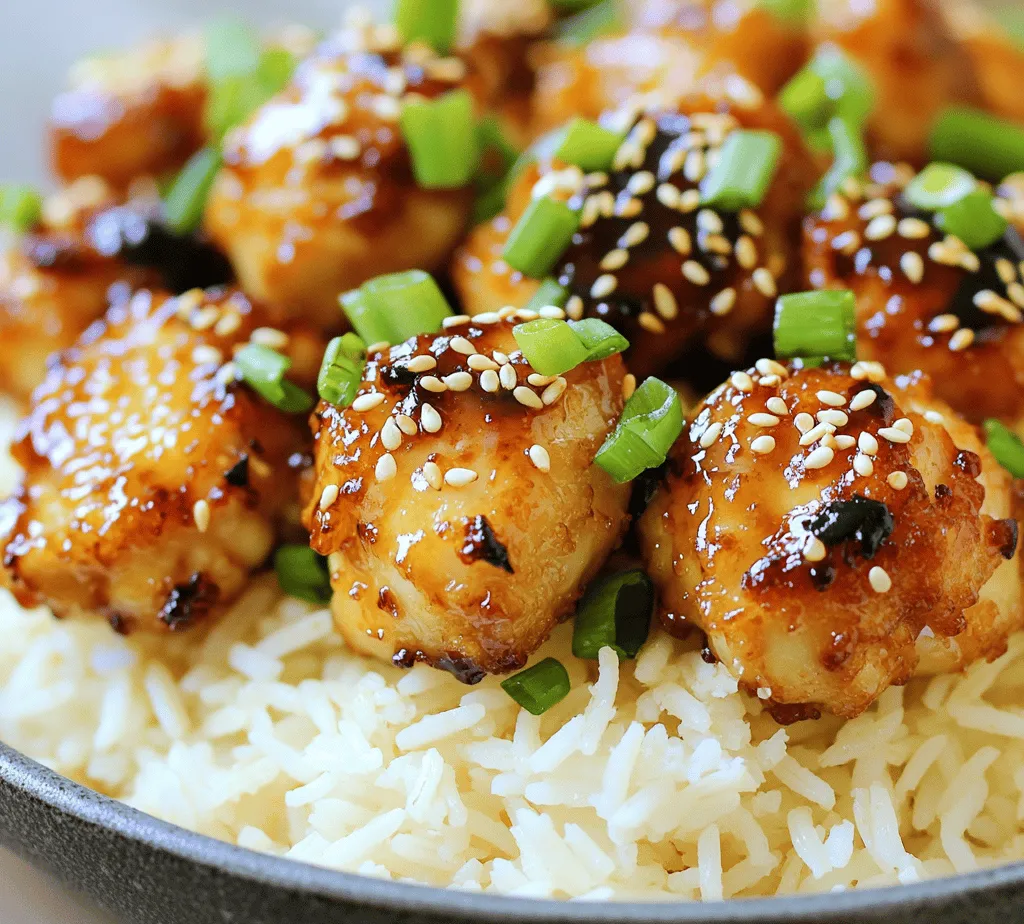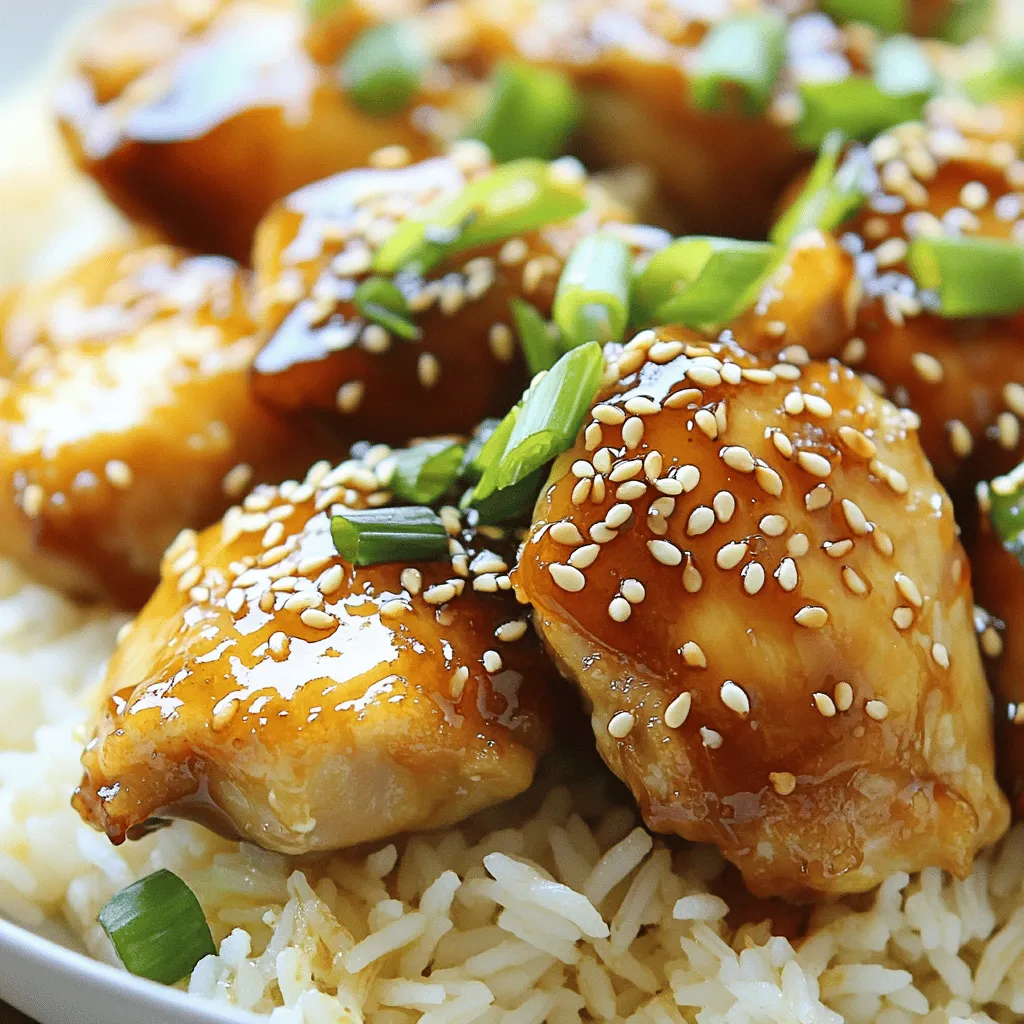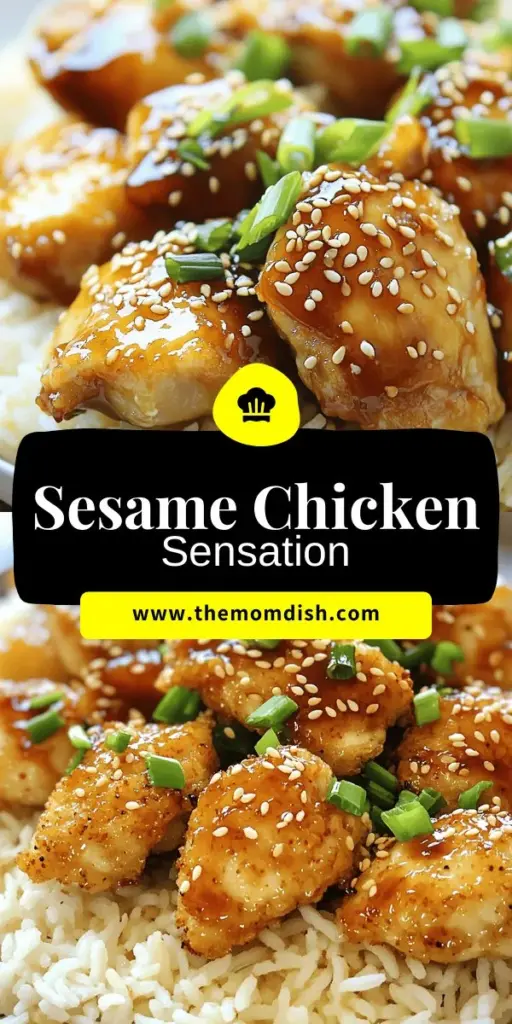Introduction
Asian cuisine has captivated the taste buds of food lovers across the globe, offering a delightful array of flavors, textures, and aromas that tantalize the palate. Among the myriad of dishes within this culinary tradition, sesame chicken stands out as a household favorite, known for its perfect balance of sweetness and savory goodness. This dish has become a staple in many restaurants and home kitchens alike, emerging as a go-to option for family dinners or gatherings.
Today, we invite you to discover the magic of “Sesame Chicken Delight,” a recipe that encapsulates the essence of this beloved dish while allowing you the flexibility to customize it to your tastes. This delightful creation features tender, crispy chicken pieces enveloped in a rich, flavorful sauce that is sure to impress your family and friends. Making this dish from scratch not only guarantees freshness but also allows you to tweak the ingredients according to your preferences. Plus, it’s surprisingly easy to prepare, making it an ideal choice for both novice cooks and seasoned chefs.
In this article, we will delve into the ingredients that make this recipe extraordinary, explore their unique benefits, and guide you through the preparation steps to ensure your sesame chicken turns out perfectly every time.
Understanding the Ingredients
The foundation of any great recipe lies in its ingredients, and “Sesame Chicken Delight” is no exception. Let’s break down the key components of this dish and understand why each ingredient is crucial for creating a mouthwatering experience.
Boneless, Skinless Chicken Thighs
The choice of protein for this dish is paramount, and boneless, skinless chicken thighs are the star of the show. Unlike chicken breasts, which can often dry out during cooking, chicken thighs offer a higher fat content, resulting in a richer flavor and juicier texture. The tenderness of the thighs enhances the overall enjoyment of the dish, ensuring that each bite is succulent and satisfying. Additionally, thighs are generally more forgiving during cooking, making them a reliable option for home cooks looking to achieve that perfect crispiness without the risk of overcooking.
Cornstarch
One of the secrets to achieving the delightful crunch of sesame chicken lies in the use of cornstarch. This versatile ingredient plays a critical role in creating a crispy coating that envelops the chicken pieces during frying. Cornstarch has a unique ability to absorb moisture and create a barrier between the chicken and the hot oil, resulting in a texture that is both light and crispy. For the best results, it’s essential to coat the chicken evenly with cornstarch, ensuring a consistent crunch throughout.
Sesame Seeds
No sesame chicken would be complete without the distinct flavor and visual appeal of sesame seeds. These tiny seeds are packed with nutritional benefits, including healthy fats, protein, and various vitamins and minerals. Moreover, sesame seeds contribute a nutty flavor that complements the sauce and enhances the overall profile of the dish. Toasting the sesame seeds before using them can elevate their flavor, adding a warm, toasty note that enriches the dish’s aroma.
Vegetable Oil
Frying is a critical step in preparing sesame chicken, and the choice of oil can make a significant difference in the final result. Vegetable oil is an excellent option for frying due to its high smoke point, which allows for efficient frying without burning. Additionally, its neutral flavor ensures that it won’t overpower the other ingredients. Other suitable oils include canola oil or peanut oil, both of which can add unique flavor notes to your dish while maintaining the essential crispiness.
Garlic and Ginger
Garlic and ginger are foundational ingredients in Asian cooking, and they bring an incredible depth of flavor to sesame chicken. Garlic adds a pungent aroma and savory richness that enhances the sauce, while ginger imparts a warm, zesty flavor profile that balances the sweetness of the dish. Both ingredients are also known for their health benefits, including anti-inflammatory properties and digestive support, making them an excellent addition to this recipe.
Soy Sauce and Alternatives
Soy sauce serves as a primary flavoring agent in the sesame chicken sauce, providing the essential umami flavor that characterizes many Asian dishes. You have the option to use traditional soy sauce or explore gluten-free alternatives, such as tamari or coconut aminos. These alternatives maintain the savory taste while catering to various dietary needs. The choice of soy sauce can significantly influence the flavor profile, so select one that aligns with your personal preferences.
Honey and Rice Vinegar
The balance of sweetness and acidity in the sauce is pivotal for achieving the signature flavor of sesame chicken. Honey serves as the sweetener, offering a natural sweetness that beautifully complements the savory elements. Rice vinegar, on the other hand, introduces a tangy acidity that brightens the dish and enhances its overall depth of flavor. When combined, these ingredients create a harmonious sauce that envelops the chicken in a delicious embrace.
Sesame Oil
A drizzle of sesame oil is a must for this recipe, as it adds a unique flavor that is distinctively Asian. Its rich, nutty taste elevates the dish and contributes to the overall complexity of flavors. Use sesame oil sparingly, as its potent flavor can dominate the dish if overused. A small amount goes a long way in enhancing the taste and aroma of your sesame chicken.
Red Pepper Flakes
For those who enjoy a hint of heat, red pepper flakes offer the perfect solution. These little flakes can be added to the sauce to introduce a mild spiciness that elevates the dish without overwhelming the palate. Adjust the quantity according to your heat preference, and feel free to omit them entirely if you prefer a milder flavor.
Green Onions
As a finishing touch, green onions provide a fresh garnish that enhances the presentation and flavor of sesame chicken. Their mild, oniony flavor adds a crisp texture that contrasts beautifully with the tender chicken. Simply chop the green onions and sprinkle them over the dish before serving for a pop of color and flavor.
Jasmine Rice
Finally, to complete your sesame chicken delight, serve it over a bed of fluffy jasmine rice. This fragrant rice is the perfect accompaniment, soaking up the delicious sauce while providing a neutral base that allows the flavors of the chicken to shine. The combination of sesame chicken and jasmine rice is a match made in culinary heaven, creating a satisfying meal that is sure to please.
Preparation Steps Explained
Now that we’ve explored the essential ingredients, it’s time to dive into the preparation process. By breaking down each step in detail, you’ll be equipped with the knowledge and confidence to create this dish successfully.
Coating the Chicken in Cornstarch
To achieve that perfect crispy exterior, the first step is to coat the chicken pieces in cornstarch. Here’s how to do it effectively:
1. Prepare the Chicken: Begin by cutting the boneless, skinless chicken thighs into bite-sized pieces. Aim for uniform sizes to ensure even cooking. Pat the chicken dry with paper towels to remove excess moisture; this will help the cornstarch adhere better.
2. Coat with Cornstarch: Place the chicken pieces into a large bowl or a resealable plastic bag. Sprinkle a generous amount of cornstarch over the chicken, making sure to cover all sides. If using a bag, seal it and shake gently until the chicken is well coated. For a bowl, use your hands to toss the chicken until each piece is evenly coated in cornstarch.
3. Remove Excess Cornstarch: After coating, it’s important to shake off any excess cornstarch. Too much cornstarch can lead to a gummy texture rather than a crispy one.
4. Rest the Chicken: Allow the coated chicken to rest for about 10-15 minutes. This step helps the cornstarch adhere to the chicken, ensuring a crunchy finish when fried.
By following these initial preparation steps, you are already on your way to creating a delectable Sesame Chicken Delight that is sure to impress at your next meal. In the upcoming sections, we will continue exploring how to bring this dish to life, including the frying process, sauce preparation, and serving suggestions. Stay tuned as we uncover the secrets to perfecting this beloved recipe.

Frying Technique: Maintaining Temperature for Optimal Crispiness
Achieving perfectly crispy sesame chicken starts with mastering the frying technique. The key to getting that crunch lies in maintaining the right oil temperature while frying. Use a deep-fryer or a heavy-bottomed pot to heat your oil. Ideally, the temperature should be around 350°F (175°C). If you don’t have a thermometer, you can test the oil by dropping in a small piece of batter; if it sizzles vigorously and rises to the surface, the oil is ready.
Fry the chicken in small batches, allowing enough space for the pieces to cook evenly without overcrowding the pan. Overcrowding can cause the temperature to drop, leading to soggy chicken. Each batch should take about 4-5 minutes to fry until golden brown. Once cooked, transfer the chicken to a plate lined with paper towels to absorb excess oil. This technique will ensure your sesame chicken is crispy on the outside while remaining tender and juicy on the inside.
Sautéing Garlic and Ginger: Understanding the Importance of Timing
Garlic and ginger are essential ingredients that add depth and warmth to the sesame chicken dish. However, timing is crucial when sautéing these aromatic ingredients. Begin by heating a tablespoon of oil in a skillet over medium heat. Once the oil is hot, add minced garlic and ginger, stirring constantly for about 30 seconds. This short cooking time is vital; both ingredients can burn easily, resulting in a bitter flavor that will overpower your dish.
The goal here is to infuse the oil with the fragrant flavors of garlic and ginger without allowing them to turn brown. Once they are fragrant, you can proceed to add your sauce ingredients, which will cool the pan slightly and prevent burning. This careful approach elevates the flavor profile of your sesame chicken, ensuring a delightful experience with each bite.
Sauce Creation: Balancing Flavors and Achieving the Desired Consistency
The sauce is what ties the dish together, and creating a well-balanced flavor profile is essential. In a separate bowl, combine soy sauce, honey, sesame oil, rice vinegar, and cornstarch. The soy sauce provides umami, honey adds sweetness, and sesame oil brings a nutty flavor that is characteristic of the dish. The rice vinegar contributes acidity, balancing the sweetness of the honey.
Whisk these ingredients together until smooth. As you incorporate the cornstarch, keep in mind that this will help thicken your sauce, giving it a glossy finish that clings beautifully to the chicken.
Once your garlic and ginger are sautéed and aromatic, pour the sauce mixture into the skillet. Cook on medium heat, stirring frequently until the sauce thickens, about 2-3 minutes. This step allows the flavors to meld and intensify, creating a rich coating for the chicken.
Final Cooking Steps: Ensuring the Chicken Absorbs the Sauce Flavor
With the sauce ready, add the crispy chicken pieces into the skillet. Toss the chicken in the sauce until well-coated, ensuring each piece absorbs the rich flavors. This step is crucial as it allows the chicken to soak in the sauce while still retaining its crispy texture.
Continue cooking for an additional 2-3 minutes, allowing the chicken to heat through while the sauce clings to the surface. If desired, sprinkle toasted sesame seeds over the chicken during this final cooking stage for added crunch and a beautiful presentation. Once done, remove from heat and let it rest for a minute before serving.
Nutritional Analysis
Overview of the Nutritional Content of the Dish
Sesame Chicken Delight is not only flavorful but also packs a nutritional punch. With its combination of protein-rich chicken breast, antioxidant-rich garlic and ginger, and healthy fats from sesame oil, this dish is a wholesome meal choice.
Calories, Protein, and Fat Breakdown per Serving
A typical serving of sesame chicken (approximately 1 cup) contains about 380 calories. The breakdown includes approximately 25 grams of protein, 18 grams of fat, and 30 grams of carbohydrates. This nutritional profile makes it a satisfying meal that can fuel your day without excessive calories.
Health Benefits of Ingredients Used
– Chicken: A lean source of protein that supports muscle growth and repair.
– Garlic: Known for its immune-boosting properties and potential cardiovascular benefits.
– Ginger: Offers anti-inflammatory effects and supports digestion.
– Sesame Oil: Contains healthy fats and antioxidants that can enhance heart health.
Suggestions for Healthier Modifications
For those looking to make this dish healthier, consider reducing the amount of honey used in the sauce to lower sugar content. You can also opt for brown rice instead of white rice to increase fiber intake. Adding steamed vegetables, such as broccoli or bell peppers, can enrich the dish with vitamins and minerals.
Serving Suggestions
Presentation Tips for an Appealing Dish
To create an eye-catching presentation, serve your sesame chicken on a large white or neutral-colored plate. This allows the vibrant colors of the dish to stand out. Garnish with freshly chopped green onions and additional sesame seeds for a touch of elegance. A sprinkle of red pepper flakes can also add a pop of color and a hint of spice.
Suggested Sides that Complement Sesame Chicken
Sesame chicken pairs beautifully with a variety of sides. Consider serving it alongside:
– Steamed Vegetables: Broccoli, snow peas, or bok choy add color and nutrition.
– Fried Rice: A classic accompaniment that absorbs the flavors of the dish.
– Spring Rolls: Light and crispy, they make an excellent starter or side dish.
Pairing Beverage Ideas that Enhance the Dining Experience
To elevate your meal, consider pairing it with:
– Green Tea: Its subtle flavors complement the dish without overpowering it.
– Asian Beers: Such as Sapporo or Tsingtao, which enhance the overall experience with their crispness.
Cultural Significance of Sesame Chicken
Exploration of the Origins of Sesame Chicken in Asian Cuisine
Sesame chicken has its roots in Chinese cuisine, where sesame seeds are often used in both savory and sweet dishes. Traditionally, sesame seeds symbolize good fortune and are a staple in many Asian cultures.
Its Evolution into a Popular Dish in Western Culture
In Western countries, sesame chicken has evolved into a beloved menu item in American-Chinese restaurants. While the traditional recipe may vary, the hallmark of sesame chicken remains its sweet and savory sauce combined with crispy chicken.
Discussion on Variations Found in Different Regions
Various regions adapt sesame chicken to suit local tastes. In American-Chinese cuisine, it is often sweeter and thicker than its traditional counterparts. In contrast, authentic Chinese recipes may focus more on the natural flavors of the chicken and sesame, with less emphasis on sweetness.
Conclusion
Sesame Chicken Delight is a dish that beautifully marries flavor, texture, and cultural history. From the crispy chicken to the rich, glossy sauce, this recipe highlights the joy of cooking and sharing meals with loved ones.
Recapping the key points, remember the importance of maintaining oil temperature for crispiness, the timing of sautéing garlic and ginger, and the careful balance of flavors in the sauce. We encourage you to try this recipe and experience the delightful flavors of homemade sesame chicken.
Cooking is not merely about sustenance; it’s about creating moments, sharing experiences, and nurturing relationships. So gather your ingredients, roll up your sleeves, and enjoy the process of bringing this delicious dish to life.



